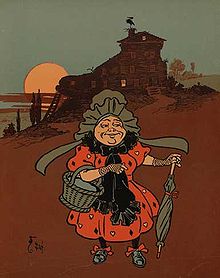W. W. Denslow



William Wallace Denslow (May 5, 1856–March 29, 1915) was an illustrator and caricaturist remembered for his work in collaboration with author L. Frank Baum, especially his illustrations of The Wonderful Wizard of Oz. Denslow was an editorial cartoonist with a strong interest in politics, which has fueled political interpretations of The Wonderful Wizard of Oz.
Born in Philadelphia, by the 1890s he was based in Chicago, where he met Baum. Besides The Wonderful Wizard of Oz, Denslow also illustrated Baum's books By the Candelabra's Glare, Father Goose: His Book, and Dot and Tot of Merryland. Baum and Denslow held the copyrights to most of these works jointly.
After Denslow quarreled with Baum over royalty shares from the 1902 stage adaptation of The Wizard of Oz, for which Baum wrote the script and Denslow designed the sets and costumes, Baum determined not to work with him again.
The royalties from the print and stage versions of The Wizard of Oz were sufficient to allow Denslow to purchase an island off the coast of Bermuda, and crown himself King Denslow I. However, he drank his money away, and on May 27, 1915, died in obscurity, of pneumonia.
Later Oz Illustrations
John R. Neill illustrated the rest of the Oz series.
In 1944, artist Evelyn Copelman became the next Oz illustrator, when she illustrated the 1944 Bobbs-Merrill edition of "The Wizard of Oz". Copelman's illustrations of the characters were largely based on the way the characters looked in the 1939 MGM film version, although the Cowardly Lion looked quite different, and Dorothy had braids rather than long pigtails, as Judy Garland did in the film.
Copelman's illustrations of the Oz characters were much less cartoon-like than those of her predecessors. They were reprinted in 1956, in the edition of The Wizard of Oz published by Grosset & Dunlap, as part of a series labeled the Illustrated Junior Library.
This edition of the book was popular throughout the 1960s, as showings of the 1939 MGM film on television gained an ever larger following. The Illustrated Junior Library edition of The Wizard is still in print today, though with a cover illustration by a different artist.
In the 1990s, Donald Abbot released several new Oz books, with illustrations that returned to the Denslow style for the first time in nearly a century. Abbot's Denslow-inspired books are How the Wizard Came to Oz (1991), The Magic Chest of Oz (1993), Father Goose in Oz (1994), and The Amber Flute of Oz (1998).
